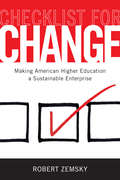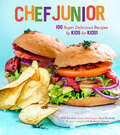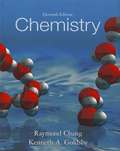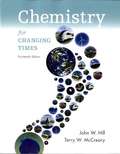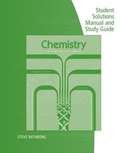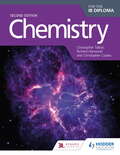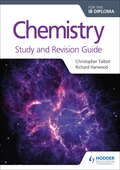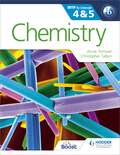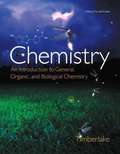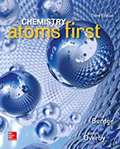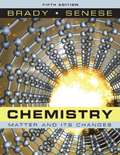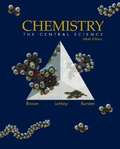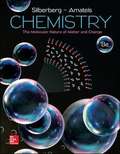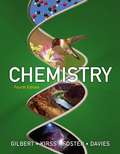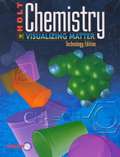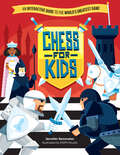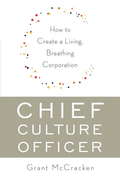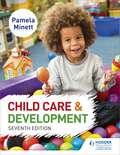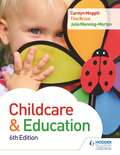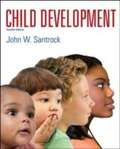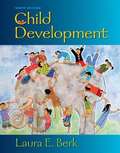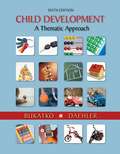- Table View
- List View
Checklist for Change: Making American Higher Education a Sustainable Enterprise
by Robert ZemskyAlmost every day American higher education is making news with a list of problems that includes the incoherent nature of the curriculum, the resistance of the faculty to change, and the influential role of the federal government both through major investments in student aid and intrusive policies. Checklist for Change not only diagnoses these problems, but also provides constructive recommendations for practical change. Robert Zemsky details the complications that have impeded every credible reform intended to change American higher education. He demythologizes such initiatives as the Morrill Act, the GI Bill, and the Higher Education Act of 1972, shedding new light on their origins and the ways they have shaped higher education in unanticipated and not commonly understood ways. Next, he addresses overly simplistic arguments about the causes of the problems we face and builds a convincing argument that well-intentioned actions have combined to create the current mess for which everyone is to blame.Using provocative case studies, Zemsky describes the reforms being implemented at a few institutions with the hope that these might serve as harbingers of the kinds of change needed: the University of Minnesota at Rochester's compact curriculum in the health sciences only, Whittier College's emphasis on learning outcomes, and the University of Wisconsin Oshkosh's coherent overall curriculum. In conclusion, Zemsky describes the principal changes that must occur not singly but in combination. These include a fundamental recasting of federal financial aid; new mechanisms for better channeling the competition among colleges and universities; recasting the undergraduate curriculum; and a stronger, more collective faculty voice in governance that defines not why, but how the enterprise must change.
Chef Junior: 100 Super Delicious Recipes by Kids for Kids! A Kids Cookbook
by Will Bartlett Anthony Spears Abigail Langford Paul Kimball Katie DessingerKids cook too! This fun and inspiring guide to preparing real food is written by kids, for kids! Cookbooks for kids often focus on bland &“child-friendly&” fare, but the authors of Chef Junior, five young cooks between the ages of 12 and 15, challenge that assumption. Instead, they present a repertoire of healthy, delicious, and inventive recipes that range from easy to advanced. Kids will love these dishes and drinks, including Tiramisu French Toast, Coconut Chicken Nuggets, Garden Fresh Pesto Pasta, Peach Cobbler, chocolate-y No-Bake Cookies, and Mango Lemonade, along with perennial favorites like mac &‘n&’ cheese, hamburgers, pizza, and tacos. In addition, children will learn how to set up a working pantry and shop for healthy, high-quality ingredients; use kitchen tools (including knives) safely and skillfully; and create meal plans the whole family will enjoy.
Chemistry (11th Edition)
by Raymond Chang Kenneth A. GoldsbyDesigned for the two-semester general chemistry course, Chang's best-selling textbook continues to take a traditional approach and is often considered a student and teacher favorite. The book features a straightforward, clear writing style and proven problem-solving strategies. It continues the tradition of providing a firm foundation in chemical concepts and principles while presenting a broad range of topics in a clear, concise manner. The tradition of Chemistry has a new addition with co-author, Kenneth Goldsby from Florida State University, adding variations to the 11th edition. The organization of the chapter order has changed with nuclear chemistry moving up in the chapter order. There is a new problem type—Interpreting, Modeling, and Estimating—fully demonstrating what a real life chemist does on a daily basis. The authors have added over 340 new problems to the book. The new edition of Chemistry continues to strike a balance between theory and application by incorporating real examples and helping students visualize the three-dimensional atomic and molecular structures that are the basis of chemical activity. An integral part of the text is to develop students' problem-solving and critical thinking skills
Chemistry (5th edition)
by Steven S. Zumdahl Susan A. ZumdahlThe fifth edition of Chemistry presents the concepts of chemistry in a clear, interesting, and student-friendly manner. Since visual material is especially important for learning general chemistry, which typically presents a pictorial view of chemical concepts, the illustrations representing the microscopic world of chemistry have been redone in this edition to improve their clarity and appearance. Special illustrations and color photographs integrate descriptive chemistry with chemical principles, and many new Chemical Impact features emphasize practical applications of newly learned concepts.
Chemistry for Changing Times
by John W. Hill Terry W. MccrearyFor non-majors introductory chemistry courses. Make chemistry relatable to all students. Chemistry for Changing Times has defined the liberal arts chemistry course and remains the most visually appealing and readable introduction to the subject. The Fourteenth Edition increases its focus on environmental and other relatable issues with revised green chemistry essays throughout and new Chemistry at Home experiments, both in the text and in MasteringChemistry. Abundant applications and examples fill each chapter and enable students of varied majors to relate to the content more readily. Updated material throughout reflects the latest scientific developments in the field demonstrating the relevance of chemistry to all students.
Chemistry for Engineering Students: Student Solutions and Study Guide
by Lawrence S. Brown Thomas A. Holme Steve RathboneThe STUDENT SOLUTIONS MANUAL AND STUDY GUIDE provides students with a comprehensive guide to working the solutions to the odd-numbered end-of-chapter problems in the text and also includes each chapter's Study Goals and Chapter Objective quizzes. Because the best way for students to learn and understand the concepts is to work multiple, relevant problems on a daily basis and to have reinforcement of important topics and concepts from the book, the STUDENT SOLUTIONS MANUAL gives students instant feedback by providing not only the answers to problems, but also detailed explanations of each problem's solution.
Chemistry for the IB Diploma Second Edition
by Christopher Coates Christopher Talbot Richard HarwoodProvide clear guidance to the 2014 changes and ensure in-depth study with accessible content, directly mapped to the new syllabus and approach to learningThis second edition of the highly-regarded first edition contains all SL and HL content, which is clearly identified throughout. Options are available free online, along with appendices and data and statistics.- Improve exam performance, with exam-style questions, including from past papers- Integrate Theory of Knowledge into your lessons and provide opportunities for cross-curriculum study- Stretch more able students with extension activities- The shift to concept-based approach to learning , Nature of Science, is covered by providing a framework for the course with points for discussion - Key skills and experiments included - Full digital package - offered in a variety of formats so that you can deliver the course just how you like!
Chemistry for the IB Diploma Study and Revision Guide
by Christopher Talbot Richard HarwoodStretch your students to achieve their best grade with these year round course companions; providing clear and concise explanations of all syllabus requirements and topics, and practice questions to support and strengthen learning. - Consolidate revision and support learning with a range of exam practice questions and concise and accessible revision notes- Practise exam technique with tips and trusted guidance from examiners on how to tackle questions- Focus revision with key terms and definitions listed for each topic/sub topic
Chemistry for the IB MYP 4 & 5: By Concept (MYP By Concept)
by Christopher Talbot Annie TermaatThe only series for MYP 4 and 5 developed in cooperation with the International Baccalaureate (IB)Develop your skills to become an inquiring learner; ensure you navigate the MYP framework with confidence using a concept-driven and assessment-focused approach presented in global contexts.- Develop conceptual understanding with key MYP concepts and related concepts at the heart of each chapter.- Learn by asking questions with a statement of inquiry in each chapter. - Prepare for every aspect of assessment using support and tasks designed by experienced educators.- Understand how to extend your learning through research projects and interdisciplinary opportunities.This title is also available in two digital formats via Dynamic Learning. Find out more by clicking on the links at the top of the page.
Chemistry: An Introduction to General, Organic, and Biological Chemistry (12th Edition)
by Karen C. TimberlakeFor one-semester courses in General, Organic, and Biological Chemistry Show the importance of chemistry in the real world Chemistry: An Introduction to General, Organic, and Biological Chemistry, Twelfth Edition is the ideal resource for today's allied health students. Assuming no prior knowledge of chemistry, author Karen Timberlake engages students through her friendly presentation style and reveals connections between the structure and behavior of matter and its role in health and the environment.
Chemistry: Atoms First
by Julia Burdge Jason OverbyThe Atoms First approach provides a consistent and logical method for teaching general chemistry. This approach starts with the fundamental building block of matter, the atom, and uses it as the stepping stone to understanding more complex chemistry topics. Once mastery of the nature of atoms and electrons is achieved, the formation and properties of compounds are developed. Only after the study of matter and the atom will students have sufficient background to fully engage in topics such as stoichiometry, kinetics, equilibrium, and thermodynamics. Thus, the Atoms First approach empowers instructors to present the most complete and compelling story of general chemistry. Far from a simple re-ordering of topics, this is a book that will truly meet the needs of the growing atoms-first market. The third edition continues to build on the innovative success of the first and second editions. Changes to this edition include specific refinements intended to augment the student-centered pedagogical features that continue to make this book effective and popular both with professors, and with their students.
Chemistry: Matters and Its Changes
by James E. Brady Fred Senese Neil D. JespersenWritten by Jim Brady, an author well known for his ability to communicate chemistry, and Fred Senese, the architect of the most visited general chemistry Web site, this book and its media are designed to support a variety of backgrounds.
Chemistry: The Central Science
by H. Eugene Lemay Theodore E. Brown Julia R. Burdge Bruce Edward BurstenThe acknowledged leader and standard in general chemistry, this book maintains its effective and proven features--clarity of writing, scientific integrity, currency, strong exercises, visual emphasis and consistency in presentation. It offers readers an integrated educational solution to the challenges of the learning with an expanded media program that works in concert with the book, helping them to approach problem solving, visualization, and applications with greater success.
Chemistry: The Molecular Nature Of Matter And Change
by Martin Silberberg Patricia AmateisChemistry: The Molecular Nature of Matter and Change by Martin Silberberg and Patricia Amateis has been recognized in the general chemistry market as an unparalleled classic. The revision for the eighth edition focused on continued optimization of the text. <p><p> To aid in this process, we were able to use data from literally thousands of student responses to questions in LearnSmart, the adaptive learning system that assesses student knowledge of course content. The data, such as average time spent answering each question and the percentage of students who correctly answered the question on the first attempt, revealed the learning objectives that students found particularly difficult, which we addressed by revising surrounding text or adding additional learning resources such as videos and slideshows. <p> The text still contains unprecedented macroscopic-to-microscopic molecular illustrations, consistent step-by-step worked exercises in every chapter, and an extensive range of end-of-chapter problems, which provide engaging applications covering a wide variety of interests, including engineering, medicine, materials, and environmental studies. <p> Changes have been made to the text and applications throughout to make them more succinct, to the artwork to make it more teachable and modern, and to the design to make it more simplistic and open.
Chemistry: The Science in Context (Fourth Edition )
by Thomas R. Gilbert Rein V. Kirss Natalie Foster Geoffrey DaviesThis book introduces the chemical principles using contexts drawn from daily life as well as from other disciplines including biology, environmental science, materials science, astronomy, geology, and medicine.
Chemistry: Visualizing Matter
by Salvatore Tocci R. Thomas Myers Keith B. OldhamChemistry textbook for college students.
Cherry Blossoms After Winter: Volume 1 (Cherry Blossoms After Winter #1)
by BamwooDespite growing up together, these childhood friends have grown apart. The fan-favorite boys&’ love manhwa turned K-drama comes to print for the first time.Seo Haebom was seven years old when his parents died in an accident. With nowhere else to go, he moves in with the family of his childhood friend Jo Taesung, who suddenly grows cold and distant, destroying their friendship.Now it&’s their senior year of high school and, after years of barely speaking to each other, Haebom and Taesung are in the same class for the first time. Haebom struggles to make friends and is plagued by bullying, but after the handsome and popular Taesung fends off his most persistent bully, everything changes—they sit together at lunch and begin to act like friends again. Haebom is unsure what to make of the shift, but this could be his last chance to mend their relationship.Volume 1 includes episodes 1–15 of the webcomic Cherry Blossoms After Winter.
Cherry Heaven
by L J AdlingtonIt is 10 years after the events in The Diary of Pelly D. A new life in The New Frontier overseas beckons Kat and Tanka, far from the terrible war in the cities, that took their parents. In a beautiful new home, Cherry Heaven, where people are building a young, liberal society, without focus on the genetic categorization and discrimination that led to the war. But all too soon Kat and Tanka find that Cherry Heaven carries haunting marks of the past. They cannot run from them, and must finally and turn and face them. Again, L. J Adlington weaves her narrative expertly from two voices, Kat, teenage, light, modern and knowing, the other a disturbed, fragmented narrative from another girl which peals away the surface of the New Frontier to expose a different and more disturbing truth. Exploring issues of postwar guilt and redemption, tension and reconciliation, framed in a fast-moving mystery, this has the same engrossing readability and accessibility as Pelly D.
Chess for Kids: An Interactive Guide to the World's Greatest Game
by Jennifer KemmeterThis engaging workbook introduces kids to the wonderful world of chess—from an explanation of every piece on the board to the fundamentals of the game and strategies to capture pieces and win—all told through fun visuals, mock games, and exciting exercises. Chess for Kids includes:A comprehensive introduction to the king, queen, knights, bishops, rooks, and pawns and how each piece moves, attacks, and defends.Detailed explanations of the basic rules of chess, tactics, strategies, mating patterns, and piece strategies.Write-in, workbook activities to help kids &‘learn by doing,&’ unlike other chess books which are text heavy and not interactive. The best offensive and defensive strategies including how to find weak spots in your opponent's defense and how to close games when most of the board&’s pieces are gone.Learn the pieces, study the strategies, and checkmate all your opponents in this complete guide to mastering the game of chess!
Chief Culture Officer: How to Create a Living, Breathing Corporation
by Grant MccrackenLevi-Strauss, the jeans and apparel maker, missed out on the hip-hop trend. They didn't realize that those kids in baggy jeans represented a whole new--and lucrative--market opportunity, one they could have seen coming if they had but been paying attention to the shape of American culture. Levi Strauss isn't alone. Too many corporations outsource their understanding of culture to trend hunters, cool watchers, marketing experts, consulting firms, and, sometimes, teenage interns. The cost to Levi-Strauss was a billion dollars. The cost to the rest of corporate America is immeasurable. The lesson? The American corporation needs a new professional. It needs a Chief Culture Officer. Grant McCracken, an anthropologist who now trains some of the world's biggest companies and consulting firms, argues that the CCO would keep a finger on the pulse of contemporary cultural trends--from sneakers to slow food to preppies--while developing a systematic understanding of the deep waves of culture in America and the world. The CCO's professionalism would allow the corporation to see coming changes, even when they only exist as the weakest of signals. Delightfully authoritative, trenchantly on point, bursting with insight and character, Chief Culture Officer is sure to expand your horizons--and your business.
Child Care and Development 7th Edition
by Pamela MinettDeliver a detailed and focused Child Development course with the 7th edition of this textbook from Pamela Minett, designed to cover all the relevant topics in concise and highly illustrated chapters. - Quickly access individual topic areas with concise, focused and clearly laid out chapters.- Build knowledge and understanding with ongoing summative questions at the end of each chapter.- Engage learners with 100s of illustrations and photographs to support understanding of key concepts.- Suitable for all Level 1 and Level 2 specifications.
Child Care and Education 6th Edition
by Tina Bruce Carolyn Meggitt Julia Manning-MortonDeliver an in depth programme of teaching for level 3 and level 4 with this classic textbook that inspires your students to go further.Written by an expert team of childcare authors, the sixth edition of this classic textbook offers an in-depth approach to Childcare and Early Years study unmatched by any course specific texts. Child Care and Education 6th Edition provides full details of all the topics and frameworks relevant to level 3 and level 4 qualifications. It offers the opportunity to analyse and explore theories and practice at a high level of detail.- Provides post level 3 material in clearly marked 'Moving On' sections at the end of each chapter.- Focuses on the practicalities of working within a real-life setting using case studies and observation tasks.- Suitable for level 3 qualifications and courses that bridge the gap between levels 3 and 4.
Child Development (12th edition)
by John W. SantrockA standard textbook that emphasizes an extremely up-to-date (more than 250 references from 1993, 1994, and in-press sources) presentation of research in the three primary domains of child development: biological processes, cognitive processes, and socioemotional processes. The changes in this edition include increased and updated coverage of culture, ethnicity, and gender; families and parenting; and health and well-being. Annotation c. by Book News, Inc., Portland, Or.
Child Development (Ninth Edition)
by Laura E. BerkA best-selling, topically organized child development text, Berk’s Child Development is relied on in classrooms worldwide for its clear, engaging writing style, exceptional cross-cultural and multi-cultural focus, rich examples, and long-standing commitment to presenting the most up-to-date scholarship while also offering students research-based, practical applications that they can relate to their personal and professional lives. Berk takes an integrated approach to presenting development in the physical, cognitive, emotional, and social domains; emphasizes the complex interchanges between heredity and environment; and provides exceptional attention to culture. Laura Berk, renowned professor and researcher, presents the latest theories and findings in the field to students in a manageable and relevant way. Berk’s signature storytelling style invites students to actively learn beside the text’s “characters,” who experience real issues in development, including physical, cognitive, and peer challenges, as well as parenting and educational concerns. Berk also helps students connect their learning to their personal and professional areas of interest. Her voice comes through when speaking directly about issues students will face in their future pursuits as parents, educators, heath care providers, social workers, and researchers. As members of a global and diverse human community, students are called on to intelligently approach the responsibility of understanding and responding to the needs and concerns of children. While carefully considering the complexities of child development, Berk presents classic and emerging theories in an especially clear, engaging writing style, with a multitude of research-based, real-world, and cross-cultural examples. Strengthening the connections among developmental domains and among theory, research, and applications, this edition's extensive revision brings forth the most recent scholarship, representing the changing field of child development.
Child Development: A Thematic Approach
by Danuta Bukatko Marvin W. DaehlerBukatko/Daehler's CHILD DEVELOPMENT: A THEMATIC APPROACH provides a comprehensive, topically organized, up-to-date picture of development from conception to adolescence. Most important, it draws students' attention to the themes that replay themselves throughout the course of development, fundamental issues that resurface continually and that provide coherence to sometimes seemingly disparate research. The themes can serve as frameworks to help students further understand and remember the multitude of facts about child development. Bukatko/Daehler's sixth edition text draws on five themes, Nature and Nurture, Sociocultural Influence, Continuity/Discontinuity, Interaction among Domains, and Risk/Resilience. By drawing on these themes, the authors hope to stimulate readers to think about the process of development, or why it proceeds as it does. Through new For Your Review and Reflection sections, the authors also hope students will engage with the text and become more adept critical thinkers, who are more likely to appreciate the ramifications of theory and research for applied issues such as parenting practices, education, and social policy for children, which are ultimately concerns for us all.
